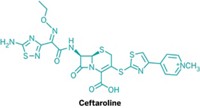Advertisement
Grab your lab coat. Let's get started
Welcome!
Welcome!
Create an account below to get 6 C&EN articles per month, receive newsletters and more - all free.
It seems this is your first time logging in online. Please enter the following information to continue.
As an ACS member you automatically get access to this site. All we need is few more details to create your reading experience.
Not you? Sign in with a different account.
Not you? Sign in with a different account.
ERROR 1
ERROR 1
ERROR 2
ERROR 2
ERROR 2
ERROR 2
ERROR 2
Password and Confirm password must match.
If you have an ACS member number, please enter it here so we can link this account to your membership. (optional)
ERROR 2
ACS values your privacy. By submitting your information, you are gaining access to C&EN and subscribing to our weekly newsletter. We use the information you provide to make your reading experience better, and we will never sell your data to third party members.
Biological Chemistry
Antibacterial molecule may discourage resistance
Agent blocks bacterial but not human RNA polymerase active site
by Stu Borman
June 16, 2017
| A version of this story appeared in
Volume 95, Issue 25

A new small molecule attacks bacteria by a mechanism that microbes could struggle to develop resistance against, according to a study. The compound, the study’s authors say, could lead to an antibiotic for drug-resistant bacteria.
Richard H. Ebright of Rutgers University and coworkers, including scientists at the drug discovery company Naicons, found the agent, pseudouridimycin, by screening for extracts from soil microbes that inhibit bacterial RNA polymerase selectively (Cell 2017, DOI: 10.1016/j.cell.2017.05.042).
The molecule blocks the active site of bacterial RNA polymerase by mimicking the structure of nucleoside triphosphates, which the enzyme uses to stitch together RNA. By preventing the nucleoside triphosphates from binding the enzyme, the agent shuts down RNA synthesis, killing the microbes. Pseudouridimycin killed different types of bacteria, including drug-resistant strains, in test tubes and cleared a streptococcal infection in mice.
The study is “beautiful work” that could “actually lead to a clinically approved antibacterial drug,” comments RNA polymerase expert Georgi Belogurov of the University of Turku.
Bacterial RNA polymerase specialist Katsuhiko Murakami of Pennsylvania State University notes that bacteria probably would struggle to develop resistance to pseudouridimycin because preventing it from binding would likely also disturb RNA polymerase’s normal function, which could be fatal to the bacteria. For example, previous studies have shown that viral mutation against the flu drug favipiravir, which directly targets the viral RNA polymerase active site, “compromises RNA polymerase activity and function,” killing the virus, Murakami says.
Because bacterial RNA polymerase’s nucleoside triphosphate binding site has a structure and sequence similar to those of human RNA polymerases, most researchers thought it would be impossible for a molecule to block it selectively, Ebright says. But pseudouridimycin achieves this selectivity because it has a side chain that also binds an adjacent site conserved in bacterial but not human RNA polymerases.
What’s more, the study found that pseudouridimycin develops resistance an order of magnitude more slowly than does rifampin, an antibiotic that binds to another part of bacterial RNA polymerase.






Join the conversation
Contact the reporter
Submit a Letter to the Editor for publication
Engage with us on Twitter